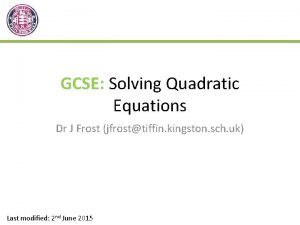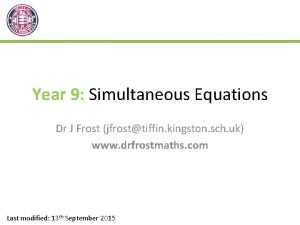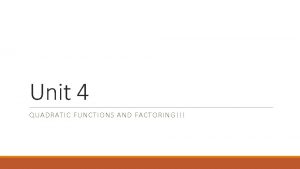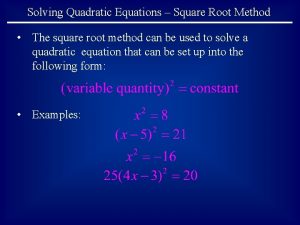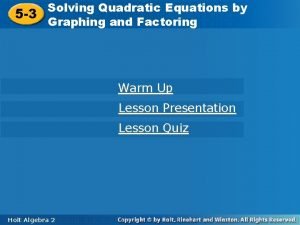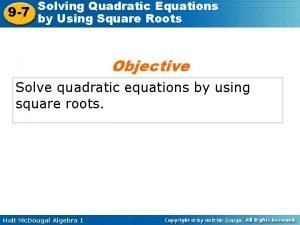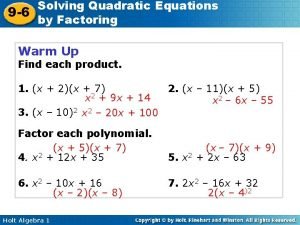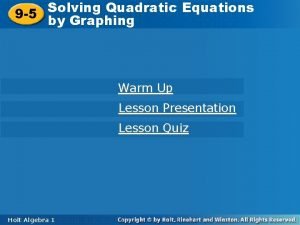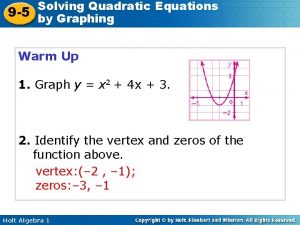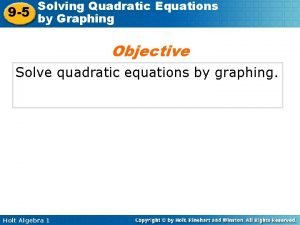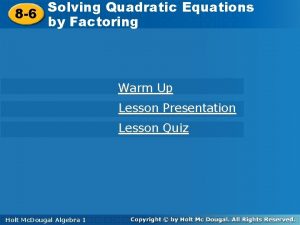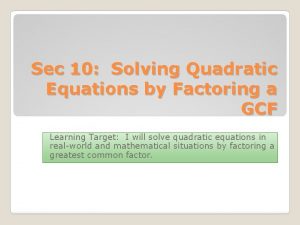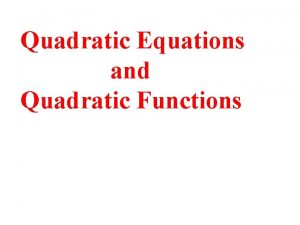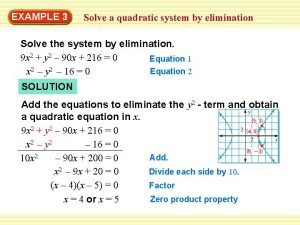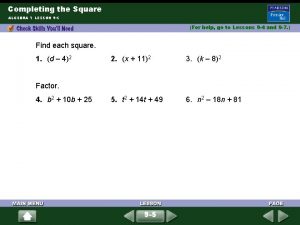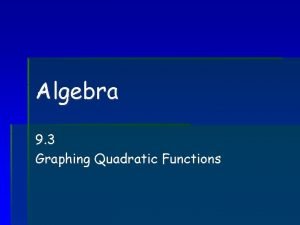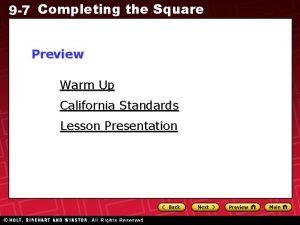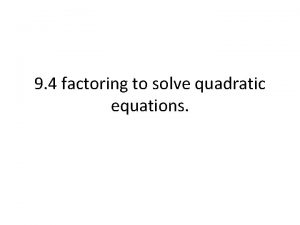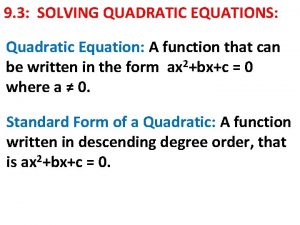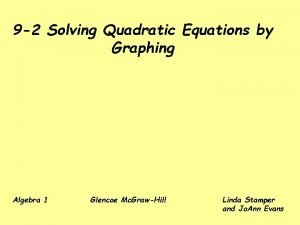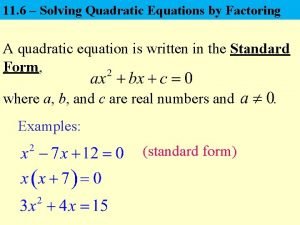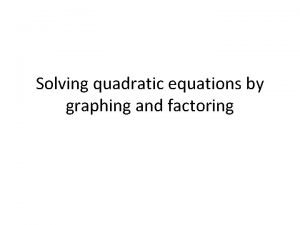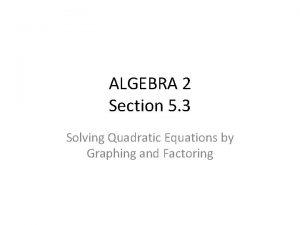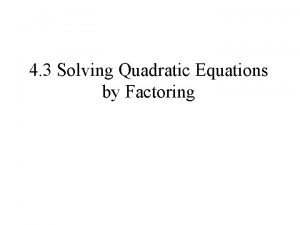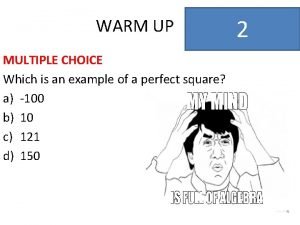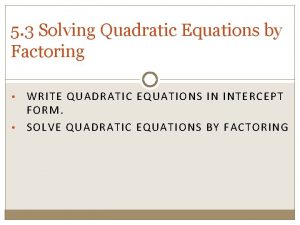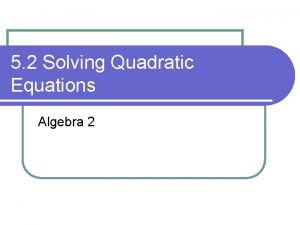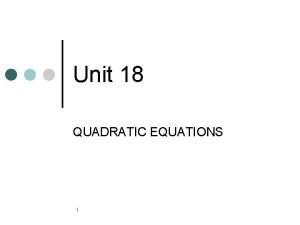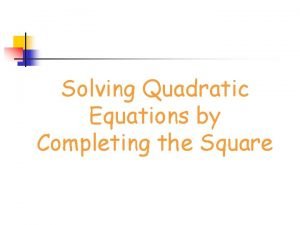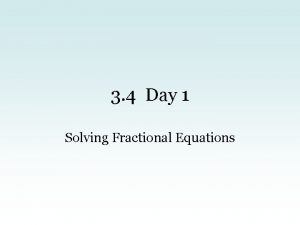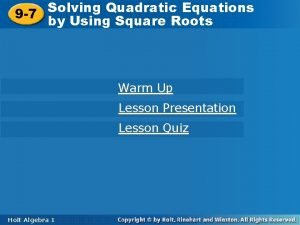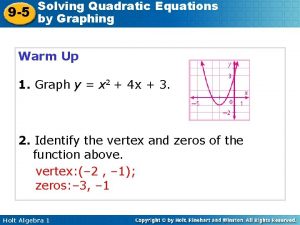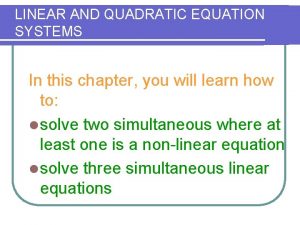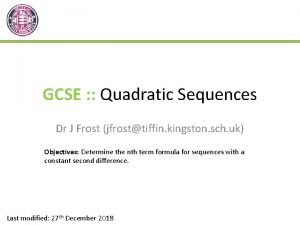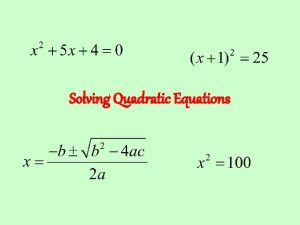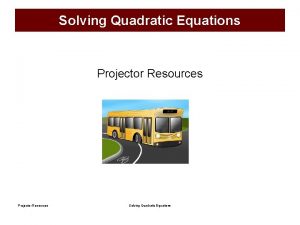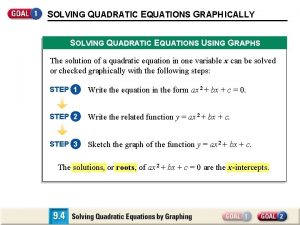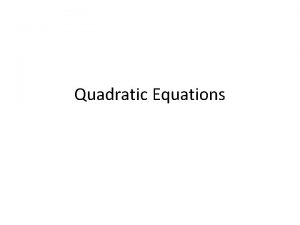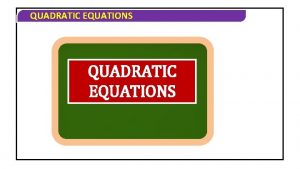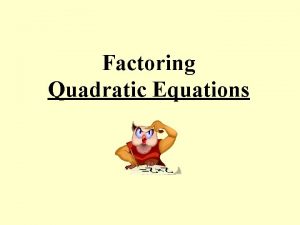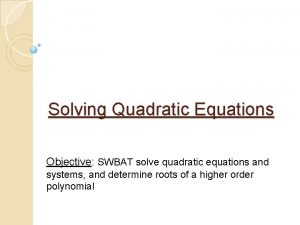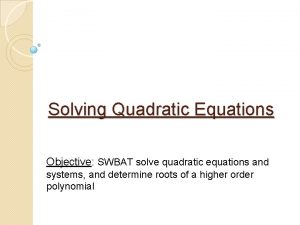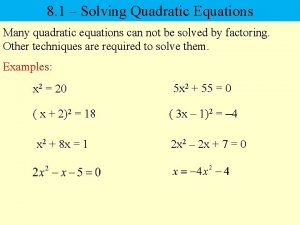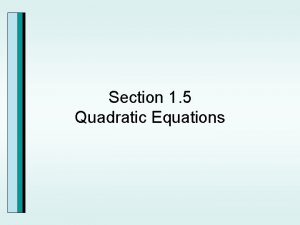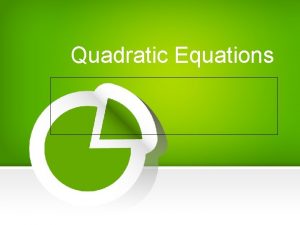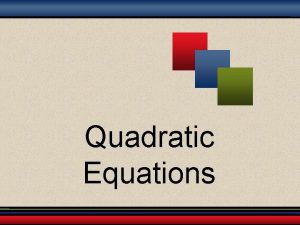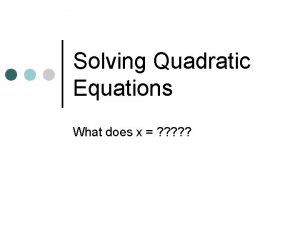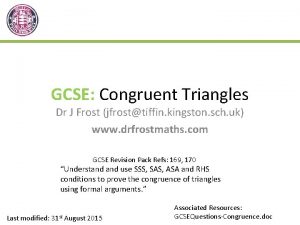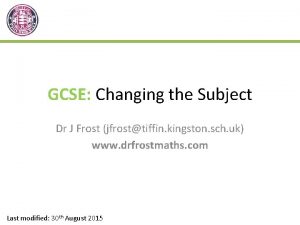GCSE Solving Quadratic Equations Dr J Frost jfrosttiffin









































- Slides: 41

GCSE: Solving Quadratic Equations Dr J Frost (jfrost@tiffin. kingston. sch. uk) Last modified: 2 nd June 2015

Overview There are 4 ways in which we can solve quadratic equations. 1 By Factorising Go To Slides >> 2 By ‘Completing the Square’ ? >> ? ? 3 By using the Quadratic Formula >> 4 Approximating by using a Graph ? >>

Recap of Factorisation Factorise the following expressions: x 2 + 9 x – 10 9 x 2 – 4 x (x + 10)(x ? – 1) Yes: it was a sneaky trick question. Deal with it. x(9 x – 4) ? 1 – 25 y 2 (1 + 5 y)(1? – 5 y) 2 x 2 + 5 x – 12 (2 x – 3)(x ? + 4) x 3 – 2 x 2 + 3 x – 6 (x 2 + 3)(x –? 2)

Solving (quadratic) equations But now we’re moving on. . . Quadratic Expression Equation x 2 – 5 x + 6 = 0 Click to Move On

Starter = 0 If two things multiply to give 0, what do you know? At least one of those ? things must be 0.

Solving Equations Therefore, how could we make this equation true? ? or ? ?

Quickfire Questions Solving the following. (x – 1)(x + 2) = 0 x = 1 or x? = -2 x(x – 6) = 0 x = 0 or x? = 6 (6 – x)(5 + x) = 0 x = 6 or x? = -5 (2 x + 1)(x – 3) = 0 x = -0. 5 or? x = 3 (3 x – 2)(5 x + 1) = 0 x = 2/3 or? x = -1/5 (1 – 4 x)(3 x + 2) = 0 x = 1/4 or? x = -2/3 Bro Tip: To get the solution quickly in your head, negate the sign you see, and make the constant term the numerator.

Exercise 1 Solving the following equations. 1 2 3 4 5 6 7 8 N N x(x – 3) = 0 x(x + 2) = 0 (x + 7)(x – 9) = 0 (7 x + 2)(x – 4) = 0 (9 – 2 x)(10 x – 7) = 0 x(5 – x)(5 + 2 x) = 0 x 2(x + 3) = 0 x(2 x – 5)(x + 1)2 = 0 x cos(x) = 0 cos(2 x + 10) = 0 x = 0 or x = 3 ? x = 0 or x = -2? x = -7 or x = 9? x = -2/7 or x =? 4 x = 9/2 or x = ? 7/10 x = 0 or x = 5 or ? x = -5/2 x = 0 or x = -3? x = 0 or x = 5/2 ? or x = -1 x = 0 or x = 90, ? 270, 450, . . . x = 40, 130, 220, ? 310, . . .

Solving non-factorised equations We’ve seen that solving equations is not too difficult when we have it in the form: [factorised expression] = 0 x 2 + 2 x – 15 = 0 (x + 5)(x – 3) = 0 x = -5 or x = 3 Put in form [expression] = 0 ? Factorise

In pairs. . . In pairs, discuss what solutions there are to the following equation. x 3 – x = 0 x(x 2 – 1) = 0 x(x + 1)(x – 1) = 0 x = 0 or x ? = -1 or x = 1

Final example Solve the following. Method 1 Method 2 Square root both sides. Factorise. x = 2 ? x 2 – 4 = 0 ? (x + 2)(x – 2) = 0 x = 2

Exercise 2 Solve the following equations. 1 2 3 4 5 6 7 8 9 10 11 12 13 x 2 + 7 x + 12 = 0 x 2 + x – 6 = 0 x 2 + 10 x + 21 = 0 x 2 + 2 x + 1 = 0 x 2 – 3 x = 0 x 2 + 7 x = 0 2 x 2 – 2 x = 0 x 2 – 49 = 0 4 x = x 2 10 x 2 – x – 3 = 0 12 y 2 – 16 y + 5 = 0 64 – z 2 = 0 2 x 2 = 8 ? x = -3 or? x = 2 x = -7 or? x = -3 x = -1 ? x = 0 or ? x=3 x = 0 or ? x = -7 x = 0 or ? x=1 x = -7 or? x = 7 x = 0 or ? x=4 x = -1/2 ? or x = 3/5 y = 1/2 or ? y = 5/6 z = 8 ? x = 2 ? x = -3 or x = -4 14 15 16 17 18 19 20 21 N N N 16 x 2 – 1 = 0 x 2 + 5 x = 14 2 x 2 + 7 x = 15 2 x 2 = 8 x + 10 4 x 2 + 7 = 29 x y 2 + 56 = 15 y 63 – 2 y = y 2 8 = 3 x 2 + 10 x x 6 = 9 x 3 – 8 x 4 = 5 x 2 – 4 x 3 = x 2 + x – 1 x 3 + 1 = – x 2 x 4 + 2 x 3 = 8 x + 16 ? x = -7 or? x = 2 x = -5 or? x = 3/2 x = -1 or? x = 5 x = 1/4 ? or x = 7 y = 7 or? y=8 x = -9 or? x = 7 x = -4 or? x = 2/3 x = 1 or? x=2 ? 2 x = 1 or x = 1 ? x = -1 ? x = 2 ? x = 1/4

Harder Equations Sometimes it’s a little trickier to manipulate quadratic (and some other) equations to solve, but the strategy is always the same: get into the form [something] = 0 then factorise (you may need to expand first). 2 x(x – 1) = 2 (x+1) 2 x 2 – 2 x 2 = x 2 + 2 x + 1 – 5 x 2 – 4 x + 4 = 0 (x – 2) =? 0 x=2 – 5

Test Your Understanding Solve (x – 4)2 = x + 8 x = 1 or x = 8 ? A* GCSE Question Alert! 5(2 x + 1)2 = (5 x – 1)(4 x + 5) 5(4 x 2 + 4 x + 1) = 20 x 2 + 25 x – 4 x – 5 20 x 2 + 20 x + 5 = 20 x 2 + 21 x – 5 ? x = 10 (It turned out this simplified to a linear equation!)

Exercise 3 Solve the following equations. 1 2 3 4 5 6 7 8 9 10 11 N ? ? ? Determine x 3 x - 1 x x+1 x = 8/7 ? N For what n is the nth term of the sequence 21, 26, 35, 48, 65, . . . and the sequence 60, 140, 220, 300, 380, . . . the same? 2 n 2 – n + 20 = 80 n – 20 n = 40 (you can’t have the ? 0. 5 th term!)

Geometric Algebraic Problems ? 2 x 2 + 27 x – 26 x – 351 = 0 (by splitting middle term) x(2 x + 27) – 13(2 x + 27) = 0 (x – 13)(2 x + 27) = 0 x = 13 ?

Geometric Algebraic Problems First triangle: a 2 + b 2 = c 2 Second triangle: (a+1)2 + (b+1)2 = (c+1)2 a 2 + 2 a + 1 + b 2 + 2 b + 1 = c 2 + 2 c + 1 ? Using (1) to substitute c 2 with a 2 + b 2 in (2): c 2 + 2 a + 2 b + 2 = c 2 + 2 c + 1 2 a + 2 b + 1 = 2 c (1) (2) The LHS of the equation must be odd since 2 a and 2 b are both even. ? even. Thus a, b and c can’t be integers. The RHS however must be even since 2 c is

Exercises Determine x 1 3 2 x - 1 Determine the length of the hypotenuse. x+4 x x+1 Determine x Answer: x = 6 ? ? Answer: ? x=6 x x+1 5 x + 2 Area = 28 4 x-4 Given the two triangles have the same area, determine x. ? Answer: x = 2 4 x + 2 x+1 Answer: x = 5 4 x 3 x - 4 2 x Area = 96 x x+2 Answer: ? x=3 2 Determine x 5 N [Maclaurin] An arithmetic sequence is one in which the difference between successive terms remains constant (for example, 4, 7, 10, 13, …). Suppose that a right-angled triangle has the property that the lengths of its sides form an arithmetic sequence. Prove that the sides of the triangle are in the ratio 3: 4: 5. Solution: Making sides x – a, x and x + a, we obtain x = 4 a by Pythagoras. Thus sides are 3 a, 4 a, 5 a which are in desired ratio. ?

Test Your Topic Understanding …of solving by factorising. 1 ? 2 ?

#2 Solving by using the Quadratic Formula Try to solve the following by factorising. What problem do you encounter? There are no two integers numbers which add to give 2 and multiply to give -5. We therefore can’t factorise. ? We can use something called the Quadratic Formula to find solutions to quadratic equations (whether or not they factorise).

The Quadratic Formula Bro Tip #1: Notice that we need 0 on the RHS. ? ? ? Bro Tip #2: You know you won’t be able to factorise if a GCSE question ends with “to 3 sf” or “to 2 dp”.

Test Your Understanding Equation Solutions (to 3 sf) ? ? ? ? ? ? ? No solutions. ?

Exercises 1 Solve the following, giving your answers as (a) exact answers (involving surds) and (b) to 3 significant figures. 2 Solve the following. Use exact values. ? ? ? ? 3 ? ? N 1 ? ? ? ? N 2 ?

Check Your Understanding Q Solve 2 x 2 – 7 x – 3 = 0, giving your answer to 3 significant figures. a = 2, b = -7, c = -3 ? What kind of mistakes do you think might be easy to make? 1. If b is negative, then putting –b as negative as well. i. e. Using -7 in the fraction instead of 7. 2. When squaring a negative value of b, putting the result as negative. i. e. Using -49 in the fraction instead of? 49. 3. When doing the -4 ac bet, subtracting instead of adding when one of a or c is negative. i. e. Using -24 in the fraction instead of +24.

#3 Solving by Completing the Square Before we solve equations by completing the square, we’ll learn how to complete the square with a quadratic expression. What the devil is ‘completing the square’? ? What’s the point? It has four uses, the first two of which we will explore: 1. 2. 3. 4. Solving quadratic equations (including deriving the quadratic formula!). ? Sketching quadratic equations. Helps us to ‘integrate’ certain expressions (an A Level topic!) Helps us do something called ‘Laplace Transforms’ (a university topic!)

#3 Solving by Completing the Square Before we solve equations by completing the square, we’ll learn how to complete the square with a quadratic expression. What the devil is ‘completing the square’? ? What’s the point? It has four uses, the first two of which we will explore: 1. 2. 3. 4. Solving quadratic equations (including deriving the quadratic formula!). ? Sketching quadratic equations. Helps us to ‘integrate’ certain expressions (an A Level topic!) Helps us do something called ‘Laplace Transforms’ (a university topic!)

Starter Expand the following: ? ?

Completing the square ?

Completing the square More examples: ? ? ?

Exercises 1 2 3 4 ? ? 5 6 7 8 9 10 N ? ? ? ?

? ? Now expand out the outer brackets. ? ? Bro Tip: Be jolly careful with your signs! ? ? Bro Tip: You were technically done on the previous line, but it’s nice to reorder the terms so it’s more explicitly in the requested form.

Test Your Understanding ? ? ?

Exercises 1 ? ? ? ? 2 3 4 5 6 ? 7 ? N ? ?

Uses of Completing The Square 1. Sketching Parabolas You can find this in the ‘Sketching Quadratic Equations’ slides. Completing the square allows us to find the minimum or maximum point of a curve, and is especially useful for sketching when the quadratic has no ‘roots’. 2. Solving Quadratics ? ? Complete the square on LHS. Move lone constant to other side.

Solving by Completing the Square Possible GCSE question ? ? Bro Tip: Be careful to observe how the question asks you to give your solution. If it says exact solution, then you have to use surds, because any decimal form would be a rounded value.

Test Your Understanding Complete the square to find exact solutions to… ? ?

Exercises Solve the following by completing the square, giving your answers to 3 sf. ? ? ? 1 2 3 4 5 6 N 1 ? N 2 ? N 3 ?

Summary So Far… #1 Factorising ? #2 Using the Quadratic Formula ? #3 Completing the Square ?

Proof of the Quadratic Formula! by completing the square… ? ? ?

#4 Solving Quadratics by using a Graph - Preview Edexcel Nov 2011 Non. Calc Recall that we can find the solutions to two simultaneous equations by drawing the two lines, and finding the points of intersection. ? ? ?

#4 Solving Quadratics by using a Graph - Preview We’ll come back to this topic in ‘Sketching Graphs’.
 Matt damon
Matt damon Dr frost simultaneous equations
Dr frost simultaneous equations Quadratic formula
Quadratic formula The area of a rectangular fountain is (x^2+12x+20)
The area of a rectangular fountain is (x^2+12x+20) Quadratic equation solve formula
Quadratic equation solve formula Square root method examples
Square root method examples Factoring zero product property
Factoring zero product property Factoring by square roots
Factoring by square roots 5-3 solving quadratic equations by factoring answer key
5-3 solving quadratic equations by factoring answer key 9-7 solving quadratic equations by using square roots
9-7 solving quadratic equations by using square roots 9-6 solving quadratic equations by factoring
9-6 solving quadratic equations by factoring 9-5 solving quadratic equations by graphing
9-5 solving quadratic equations by graphing 9-5 solving quadratic equations by graphing
9-5 solving quadratic equations by graphing 9-5 solving quadratic equations by graphing
9-5 solving quadratic equations by graphing Factoring method quadratic equations
Factoring method quadratic equations Solving quadratic equations by gcf worksheet
Solving quadratic equations by gcf worksheet Quadratic equation vocabulary
Quadratic equation vocabulary Solving quadratic equations by elimination
Solving quadratic equations by elimination 9-5 solving quadratic equations by completing the square
9-5 solving quadratic equations by completing the square Section 5 topic 3 solving quadratic equations by factoring
Section 5 topic 3 solving quadratic equations by factoring 9-3 practice solving quadratic equations by graphing
9-3 practice solving quadratic equations by graphing Topic 9 solving quadratic equations
Topic 9 solving quadratic equations Completing the square examples
Completing the square examples 9-4 solving quadratic equations by factoring
9-4 solving quadratic equations by factoring 9-3 solving quadratic equations
9-3 solving quadratic equations 9-2 solving quadratic equations by graphing
9-2 solving quadratic equations by graphing Site:slidetodoc.com
Site:slidetodoc.com How to find roots of equation
How to find roots of equation Section 5 topic 3 solving quadratic equations by factoring
Section 5 topic 3 solving quadratic equations by factoring Choose the methods of solving quadratic equations
Choose the methods of solving quadratic equations 4-3 solving quadratic equations by factoring
4-3 solving quadratic equations by factoring Solving quadratic equations multiple choice questions doc
Solving quadratic equations multiple choice questions doc 5-3 solving quadratic equations by factoring
5-3 solving quadratic equations by factoring 5-2 solving quadratic equations by graphing
5-2 solving quadratic equations by graphing Which is an example of incomplete quadratic function?
Which is an example of incomplete quadratic function? Completing the square equation
Completing the square equation Solving fractional quadratic equations
Solving fractional quadratic equations Solving quadratic equations
Solving quadratic equations 9-7 solving quadratic equations by using square roots
9-7 solving quadratic equations by using square roots 9-5 solving quadratic equations by graphing
9-5 solving quadratic equations by graphing Systems of linear and quadratic equations
Systems of linear and quadratic equations Quadratic equation by factoring definition
Quadratic equation by factoring definition
